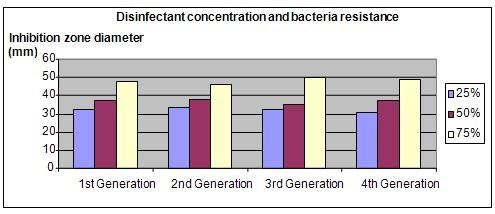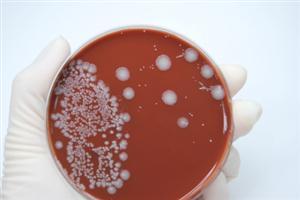| Complexity level: | 9 |
| Project cost ($): | 90 |
| Time required: | 1 day for preparation, 8 days for the science project experiment |
| Material availability: | Access to laboratory equipment (eg. petri dishes) |
| Safety concerns: | Always follow laboratory safety guidelines and always practice sterile technique when handling microbes. Never have any food or drink at your workstation and always thoroughly wash your hands with disinfectant soap or alcohol before leaving your workstation. Always dispose of used material in a biohazard bag. If none are available, the bacteria should be destroyed with bleach before being disposed of. |
Hypothesis
Lower disinfectant concentrations cause the bacteria to develop resistance more quickly.
Overview
Bacterial resistance
Bacteria and other microorganisms exist all around us. Most of them are harmless to humans. Some assist us in digesting our food while others make us sick. This is why disinfectants should be used regularly to reduce the growth of these harmful bacteria.
However, disinfectant overuse leads to bacteria resistance, whereby the bacteria develops an immunity towards the disinfectant and makes it ineffective in killing the bacteria. This is also true for bacteria resistance towards antibiotics. This may lead to the growth and multiplication of a new population of resistant bacteria.
Scientific Terms
Materials
The materials required for this science fair project are:
- 12 agar Petri dishes
- 12 disinfected swabs
- 1 bottle of disinfected water
- A filter paper
- A hole puncher
- 4 test tubes
- 1 measuring cylinder
- 1 bottle dettol disinfectant
- 1 beaker of water
- E. Coli bacteria culture (may be purchased online if it is not already available in your lab)
- 1 pair of sterile forceps
- 1 marker pen
Procedure
1. The independent variable for this experiment is the concentration of dettol disinfectant used – 25%, 50% and 75%. The dependent variable is the size of the inhibition zone which refers to the area free of bacteria). This is determined by measuring its diameter using a ruler. The constants (control variables) are room temperature, amount of sunlight and the ingredients in the Petri dish agar.
2. Prepare 12 Petri dishes of agar and store them in the refrigerator.
3. Three Petri dishes are taken out of the refrigerator and allowed to attain room temperature. Label the dishes - 25%, 50% and 75%.
4. Mix the dettol disinfectant with water in the test tube and label them as follows :
a. 25% - 25ml of dettol disinfectant mixed with 75ml of water
b. 50% - 50ml of dettol disinfectant mixed with 50ml of water
c. 75% - 75ml of dettol disinfectant mixed with 25ml of water
5. Mix the fourth test tube with 10ml of E. Coli bacterium and 40ml of water
6. Punch out circular discs of filter paper using the hole puncher. The discs are separated into three groups and also labeled as 25%, 50% and 75%.
7. Wash the swab using the disinfected water and dip it into the test tube containing the bacteria culture. The swab is then gently rubbed all over the agar surface of the 3 Petri dishes. It is important to ensure that you cover the entire surface of the petri dish thoroughly. To do this, you should swab in at least 3 directions.
8. Pick up the filter paper discs using the forceps and dipthem into the test tubes containing the different concentrations of dettol. They are then removed from the test tubes and placed in the middle of the Petri dishes according to how they are labeled. . Cover the Petri dishes and keep them in a cool shaded place for the next 2 days for the bacteria to grow.
9. After 2 days there will be a circular area on the agar called the inhibition zone which is the area surrounding the paper disc without any bacteria growth. The diameter of this area is measured and recorded in the table provided below. The concept of the inhibition zone is attributed to the Kirby-Bauer disk diffusion method. This method is used by microbiologists to assess the effectiveness of antimicrobial agents. As the dettol diffuses out from the filter paper into the agar, there will be a higher concentration of dettol nearer the disk. This concentration decreases gradually, as the distance from the edge of the disc increases. As long as the concentration of dettol at any given distance is high enough to properly act as an antibacterial agent, no bacteria will grow at that location. Hence, if the bacteria has increased resistance, a smaller inhibition zone will be seen, and vice versa.
10. The bacteria living around the border of the inhibition zone is collected using a swab and used to create the next batch of bacteria culture as explained in step 5.
11. Steps 3 to 10 are repeated another 3 times using the bacteria culture harvested according to step 10 and the results observed are recorded in the table provided below.

Results
The results show that a higher concentration of dettol disinfectant result in a larger inhibition zone. However there is no significant change in the relative sizes of the inhibition zones after 4 generations - indicating no change in bacteria resistance.
| Dettol disinfectant concentration | Diameter of the area around the filter paper disc without bacteria growth (mm) | |||
| 1st Generation | 2nd Generation | 3rd Generation | 4th Generation | |
| 25% | 32 | 33 | 32 | 31 |
| 50% | 37 | 38 | 35 | 37 |
| 75% | 48 | 46 | 50 | 49 |
Plot your results into a graph as shown below

Conclusion
The hypothesis that a lower concentrationof disinfectant accelerates the development of bacteria resistance is is proven to be false. However, it takes a long period of time before bacteria resistance may be observed, hence this experiment may have to be repeated many times over for any observable results.
The excessive use of disinfectants can engender bacteria resistance such that the disinfectant becomes ineffective in killing bacteria. The development of more resistant strains of bacteria means that stronger concentrations of disinfectants have to be used in order for it to be potent in controlling bacteria growth. This may have adverse consequences as strong concentrations of disinfectants are harmful to humans and the environment.
Also consider
The science fair project can be repeated by varying the types of disinfectants used, such as antibacterial soaps, Listerine or bleach.Try testing the resistance of various other kinds of bacteria.
References
Why is bacillus resistant to disinfectants? - http://www.ehow.com/how-does_5173187_bacillus-resistant-disinfectants_.html

